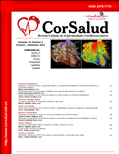Síndrome de Bland-White-Garland o ALCAPA en el adulto. Informe de un caso
Resumen
El síndrome de Bland-White-Garland o ALCAPA es una anomalía congénita relativamente rara. Existen dos tipos, infantil y del adulto, caracterizados por aspectos fisiopatológicos, clínicos y terapéuticos diferentes. Es una enfermedad que se diagnostica raramente en los adultos. Los métodos no invasivos juegan un papel importante en su diagnóstico, la angiografía por tomografía es el examen de elección para la confirmación de dicha anomalía coronaria, por su capacidad de obtener imágenes de alta calidad. Se presenta el caso de una mujer de 46 años de edad, con origen anómalo del tronco coronario izquierdo desde la arteria pulmonar, dilatación significativa de la coronaria derecha y presencia de trayectos fistulosos colaterales entre esta y la descendente anterior y fistulas arteriovenosas en el trayecto de esta misma arteria, que está ocluida distalmente por lo que produjo un infarto en los segmentos del territorio apical.Descargas
Citas
1. Dodge-Khatami A, Mavroudis C, Backer CL. Anomalous origin of the left coronary artery from the pulmonary artery: collective review of surgical therapy. Ann Thorac Surg. 2002;74(3):946-55.
2. Suresh VJ, Abhijeet VN, Parag SB, Bhushan C, Prasanna S. An experience with off pump technique for repair of anomalous left coronary artery from pulmonary artery (ALCAPA). Indian Heart J. 2016;68(5):704-708.
3. Nguyen BH, Cao KD, Thao PTH, Vo AT, Le KM. Anomalous left coronary artery from the pulmonary artery (ALCAPA) as a concealed cause of severe mitral regurgitation in children and adults: Case reports. Int J Surg Case Rep [internet]. 2020 [citado 16 Ene 2021];75:147-51. Disponible en: https://pubmed.ncbi.nlm.nih.gov/32950944/
4. Peña E, Nguyen ET, Merchant N, Dennie C. ALCAPA syndrome: not just a pediatric disease. Radiographics. 2009;29(2):553-65.
5. Brooks HS. Two Cases of an Abnormal Coronary Artery of the Heart Arising from the Pulmonary Artery: With some Remarks upon the Effect of this Anomaly in producing Cirsoid Dilatation of the Vessels. J Anat Physiol [internet]. 1885 [citado 16 Ene 2021];20:26-9. Disponible en: https://pubmed.ncbi.nlm.nih.gov/17231608/
6. Rajagopalan B, Said Z, Ford-Mukkamala L, Malhotra S. Conservative management of incidentally diagnosed ALCAPA syndrome in an asymptomatic adult. JACC. 2018;71Suppl11:A2474.
7. Abrikossoff A. Aneurysma des linken Herzventrikels mit abnormer Abgangsstelle der linken Koronararterie von der Pulmonalis bei einem fünfmonatlichen Kinde. Virchows Arch Pathol Anat Physiol Klin Med. 1911;203:413-20.
8. Bland EF, White PD, Garland J. Congenital anomalies of the coronary arteries: Report of an unusual case associated with cardiac hypertrophy. Am Heart J. 1933;8:787-801.
9. Heermann P, Heindel W, Schülke C. Coronary Artery Anomalies: Diagnosis and Classification based on Cardiac CT and MRI (CMR) - from ALCAPA to Anomalies of Termination. Rofo. 2017;189(1):29-38.
10. Patel SG, Frommelt MA, Frommelt PC, Kutty S, Cramer JW. Echocardiographic Diagnosis, Surgical Treatment, and Outcomes of Anomalous Left Coronary Artery from the Pulmonary Artery. J Am Soc Echocardiogr. 2017;30(9):896-903.
11. Wesselhoeft H, Fawcett JS, Johnson AL. Anomalous origin of the left coronary artery from the pulmonary trunk. Its clinical spectrum, pathology, and pathophysiology, based on a review of 140 cases with seven further cases. Circulation. 1968;38(2):403-25.
12. Krexi L, Sheppard MN. Anomalous origin of the left coronary artery from the pulmonary artery (ALCAPA), a forgotten congenital cause of sudden death in the adult. Cardiovasc Pathol. 2013;22(4):294-7.
13. Zhang W, Hu R, Zhu Y, Zhang W, Yu X, Sun Y, Zhu H, Zhang H. Surgical outcomes for anomalous left coronary artery from the pulmonary artery: Influence of late presentation. J Thorac Cardiovasc Surg. 2020;159(5):1945-52.
14. Yamanaka O, Hobbs RE. Coronary artery anomalies in 126,595 patients undergoing coronary arteriography. Cathet Cardiovasc Diagn. 1990;21(1):28-40.
15. Angelini P, Velasco JA, Flamm S. Coronary anomalies: incidence, pathophysiology, and clinical relevance. Circulation. 2002;105(20):2449-54.
16. Erol C, Seker M. Coronary artery anomalies: the prevalence of origination, course, and termination anomalies of coronary arteries detected by 64-detector computed tomography coronary angiography. J Comput Assist Tomogr. 2011;35(5):618-24.
17. Von Ziegler F, Pilla M, McMullan L, Panse P, Leber AW, Wilke N, et al. Visualization of anomalous origin and course of coronary arteries in 748 consecutive symptomatic patients by 64-slice computed tomography angiography. BMC Cardiovasc Disord [internet]. 2009 [citado 11 Ene 2021];9:54. Disponible en: https://bmccardiovascdisord.biomedcentral.com/articles/10.1186/1471-2261-9-54
18. Xu H, Zhu Y, Zhu X, Tang L, Xu Y. Anomalous coronary arteries: depiction at dual-source computed tomographic coronary angiography. J Thorac Cardiovasc Surg. 2012;143(6):1286-91.
Publicado
Cómo citar
Número
Sección
Licencia
Aquellos autores/as que tengan publicaciones con esta revista, aceptan los términos siguientes:- Los autores/as conservarán sus derechos de autor y garantizarán a la revista el derecho de primera publicación de su obra, el cuál estará simultáneamente sujeto a la Licencia de reconocimiento de Creative Commons que permite a terceros compartir la obra siempre que se indique su autor y su primera publicación esta revista.
- Los autores/as podrán adoptar otros acuerdos de licencia no exclusiva de distribución de la versión de la obra publicada (p. ej.: depositarla en un archivo telemático institucional o publicarla en un volumen monográfico) siempre que se indique la publicación inicial en esta revista.










